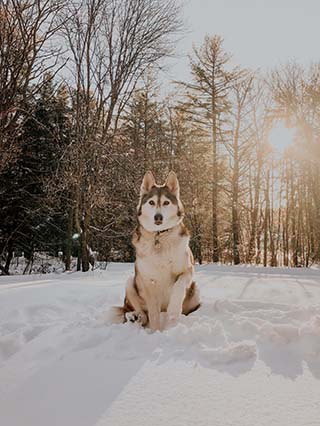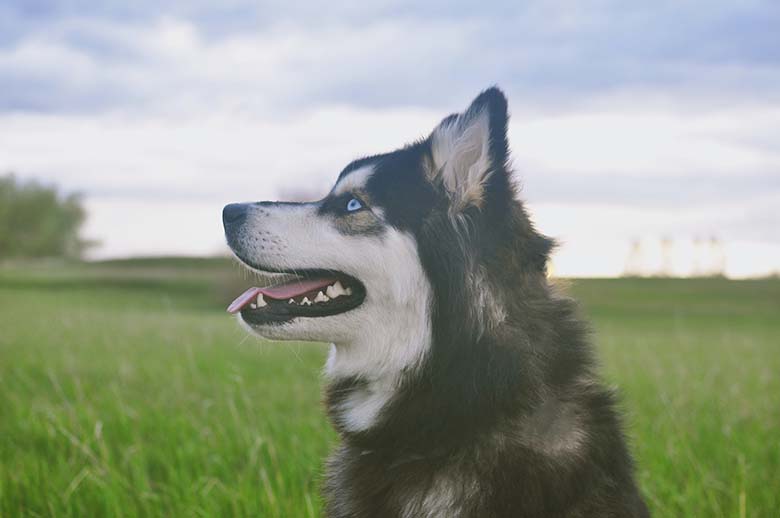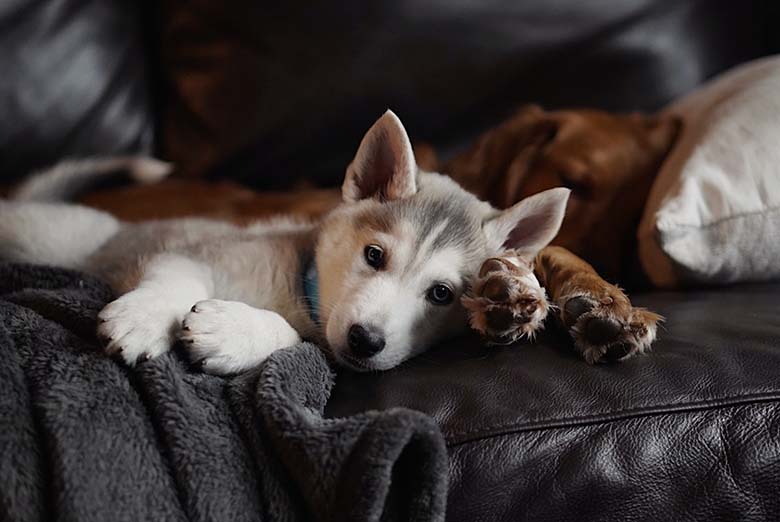Siberian Husky: Your Complete Guide
Siberian Huskies are stunningly beautiful dogs, but they are also a breed with a long past and a unique set of traits. Originating in the rough environment of Siberia, these medium-sized dogs have been able to survive harsh conditions for hundreds of years.
Their unique coat, which is often covered in beautiful markings, and their hypnotic blue eyes make them stand out in a crowd. But Huskies aren’t just good-looking; they also have a lively attitude that can make anyone fall in love with them. No matter how much you know about Huskies or how long you’ve had one, our guide will help you learn about their background, characteristics, care, and more.
Table of Contents
Siberian Husky History: A Fascinating Journey

The Siberian Husky is a breed of dog that comes from Siberia, which is a cold, harsh place. This breed has a long past. The Chukchi people were the first to breed these hardy dogs. They used them to get around and stay alive in the harsh Arctic circumstances.
Siberian Huskies are medium-sized dogs that stand out because of how they look. Most men are between 21 and 24 inches tall, while females are a bit shorter. Siberia, where they come from, is in both northeast Asia and Russia.
Huskies make great family pets because they are friendly and loyal all the time. They like to play with people and are often called “people dogs.” Their beautiful blue eyes and unique marks on their fur add to their appeal.
Siberian Huskies can live for 12–15 years, which means that people who like their unique charm can have them for the rest of their lives. In our next blog posts, we’ll talk more about the traits, care, and training of these interesting dogs.
Siberian Husky Characteristics: A 5-Star Overview
Siberian Husky Traits: What Makes Them Unique

Life Span: Siberian Huskies typically have a lifespan of 12 to 15 years, ensuring years of companionship and joy.
Country of Origin: Originating in Siberia, Russia, these resilient dogs have their roots in the harsh Arctic regions.
Size: Siberian Huskies fall into the medium-sized breed category, known for their graceful yet powerful build.
Height: Males typically stand at 53-61 cm (21-24 inches), while females are slightly smaller at 51-56 cm (20-22 inches).
Weight: Male Huskies typically weigh between 20-27 kg (45-60 pounds), while females range from 16-23 kg (35-50 pounds). These weight ranges ensure agility and athleticism.
These unique traits are just the beginning of what makes Siberian Huskies such a captivating and cherished breed. Stay tuned to learn more about their personality, care, and training in our upcoming posts.
Unlocking the Siberian Husky Personality and Lifestyle
Siberian Huskies are both independent and friendly. They are both curious and loyal. They are explorers with a bit of stubbornness, which makes them great friends. Their ability to get along with people makes them great for families.
Siberian Husky Lifestyle
When you have a Husky, you have to stay busy. It’s important to work out every day. Their double coat needs to be brushed. It is very important to meet their need for company. Stay tuned for more info about how to care for and train them.
Siberian Husky Care Unveiled: Grooming, Exercise, Diet, and Training

Taking care of your Siberian Husky is a trip that is full of rewards. Start by cleaning them and taking care of their beautiful double coat to keep them healthy and happy. Then, use their endless energy in a healthy way by getting them to exercise regularly.
Daily walks and active playtime are important. Next, pay attention to their food and nutrition, making sure they have a balanced, high-quality diet that can keep up with their active lifestyle. Lastly, start training. Huskies are smart but independent, so regular training is the key to having a well-behaved friend. Stay tuned to learn more about each part and how to make your Husky’s life as good as it can be.
Mastering Siberian Husky Grooming: Tips for a Stunning Coat
- Brush Regularly: To maintain their striking coat, brush your Siberian Husky at least once a week. This helps prevent matting and reduces shedding.
- Bathing Routine: Huskies are generally clean dogs, so avoid frequent baths. When needed, use a dog-specific shampoo and make sure to thoroughly rinse to prevent skin issues.
- Nail Care: Trim their nails regularly to avoid discomfort and potential injury. If you’re not confident doing it yourself, seek professional grooming help.
- Ear and Eye Check: Keep an eye on their ears and eyes for signs of infection or irritation. Clean them gently as needed to prevent issues.
- Seasonal Shedding: Twice a year, Huskies “blow” their coat. During this time, expect heavy shedding. Increase grooming to manage the fur.
Proper Siberian Husky grooming not only keeps them comfortable but showcases their beauty. Stay tuned for more advice on how to take care of your Husky.
Energize Your Siberian Husky: Exercise Essentials
- Daily Walks: Huskies thrive on physical activity. Take them for brisk daily walks to meet their exercise needs and stimulate their minds.
- Playtime Galore: Engage in interactive play sessions. Games like fetch, tug-of-war, and agility exercises are perfect for their active nature.
- Jogging and Running: If you’re a runner, your Husky can be an excellent jogging companion. They have the stamina to keep up with you.
- Dog Sports: Consider enrolling your Husky in dog sports like agility or obedience training. These activities challenge their intelligence and keep them engaged.
- Mental Stimulation: Don’t forget mental exercise. Puzzle toys and treat-dispensing devices can provide mental stimulation, preventing boredom.
Regular Siberian Husky exercise is essential for their well-being. It not only keeps them physically fit but also helps maintain their happy and content disposition. Stay active with your Husky, and you’ll have a loyal and energetic companion by your side.
Nourishing Your Siberian Husky: Diet and Nutrition Tips

- Balanced Diet: Opt for a high-quality, balanced diet suitable for your Husky’s age and activity level. Consult your vet for specific recommendations.
- Protein Power: Huskies thrive on a diet rich in protein. Look for dog food with real meat as the primary ingredient to support their active lifestyle.
- Portion Control: Be mindful of portion sizes to maintain a healthy weight. Overfeeding can lead to obesity, which can impact their overall health.
- Fresh Water: Ensure your Husky has access to clean, fresh water at all times. Proper hydration is crucial for their well-being.
- Treats in Moderation: Treats are great for training and bonding, but you shouldn’t give them too many of them so they don’t eat too many calories.
A well-rounded Siberian Husky diet is the cornerstone of their health and vitality. By providing the right nutrition, you’re setting the stage for a long and happy life for your beloved furry companion. Stay tuned for more insights into their care and well-being.
Mastering Siberian Husky Training: Key Insights
- Early Socialization: Start socializing your Husky as a puppy. Exposure to different people, animals, and environments helps build a confident and well-adjusted dog.
- Consistency is Key: Be consistent with commands and expectations. Huskies respond well to routine and clear boundaries.
- Positive Reinforcement: Use rewards and praise to motivate your Husky during training. They thrive on positive feedback.
- Exercise and Mental Stimulation: Incorporate training into daily exercise routines. Mental stimulation keeps them engaged and prevents boredom.
- Professional Help: If you encounter challenges, consider enlisting the assistance of a professional dog trainer experienced with Huskies.
Effective Siberian Husky training strengthens your bond and ensures a well-behaved companion. Stay tuned for more training tips and insights to make your Husky’s learning journey a rewarding one.
Safeguarding Your Siberian Husky’s Health: Common Issues and Allergies

- Hip Dysplasia: Siberian Huskies are prone to hip dysplasia, a hereditary condition. Regular vet check-ups can detect this early, and weight management and exercise moderation help reduce the risk.
- Eye Conditions: Huskies have beautiful blue eyes, but they can also have problems with their eyes. Keep an eye out for things like cataracts and gradual retinal atrophy. If you notice any changes in their eyesight, get them to a vet right away.
- Skin Problems: Allergies can affect Huskies, leading to skin irritations. Regular grooming and a balanced diet can help manage these issues. Consult your vet for guidance.
- Gastrointestinal Sensitivity: Some Huskies may have sensitive stomachs. Pay attention to their dietary needs and choose a high-quality dog food that agrees with their digestive system.
- Autoimmune Disorders: Huskies can be prone to autoimmune disorders like hypothyroidism. Regular thyroid function testing can help detect and manage this condition.
Siberian Husky health issues are a part of caring for these beautiful dogs.Even though they are more likely to get some diseases, you can keep your Husky healthy and happy with good care, good food, and regular trips to the vet. Don’t be afraid to talk to your vet if you’re worried about your Husky’s health, especially if you think he or she might have allergies or another health problem. Early detection and proactive care are key to ensuring a long and fulfilling life for your Siberian Husky.
Siberian Husky Popular Names: A Howling Good List
It can be fun to find the right name for your Siberian Husky. Here are 10 popular male names and 10 popular female names to help you decide:
- Kodiak
- Thor
- Atlas
- Maverick
- Loki
- Koda
- Shadow
- Avalanche
- Blaze
- Diesel
- Luna
- Aurora
- Maya
- Willow
- Kira
- Nala
- Bella
- Sasha
- Misty
- Tundra
Siberian Husky Frequently Asked Questions: Everything You Need to Know
Siberian Huskies are captivating dogs known for their striking appearance and unique personality. If you’re considering bringing one into your life or already have a Husky companion, you probably have some questions. Let’s dive into the answers to these common Siberian Husky FAQs:
-
Do Siberian Huskies Shed?
Yes, Siberian Huskies are known for shedding. They have a thick double coat designed to keep them warm in cold climates. Shedding occurs year-round but can increase during seasonal changes.
-
Are Siberian Huskies Hypoallergenic?
No, Siberian Huskies are not considered hypoallergenic. Their shedding can trigger allergies in sensitive individuals.
-
Are Siberian Huskies Good Apartment Dogs?
Siberian Huskies have high energy levels and a need for regular exercise. Even though they can get used to living in an apartment, it’s important to give them plenty of physical exercise and mental stimulation to keep them happy and avoid behavior problems caused by boredom.
-
Are Siberian Huskies Smart?
Yes, Siberian Huskies are intelligent dogs. They are quick learners but can also be independent thinkers, which may require patient and consistent training.
-
Are Siberian Huskies Aggressive?
Siberian Huskies are typically not aggressive by nature. They are known for their friendly and social personalities. However, like any breed, their behavior can be influenced by factors like training and socialization.
-
How Big Do Siberian Huskies Get?
Siberian Huskies fall into the medium-sized category. Adult males typically stand between 21-24 inches at the shoulder, while females are slightly smaller, ranging from 20-22 inches.
-
How Much is a Siberian Husky?
The price of a Siberian Husky can vary widely depending on factors like location, breeder reputation, and pedigree. Expect to pay anywhere from $800 to $2500 or more for a Husky puppy.
-
Do Siberian Huskies Bark a Lot?
Huskies are not known for excessive barking. They are more likely to “talk” through vocalizations like howling and “woo-wooing.” However, they may bark if they sense a threat or are excited.
-
Do Siberian Huskies Shed a Lot?
Yes, Siberian Huskies shed a significant amount, especially during seasonal changes. Regular grooming can help manage their shedding.
-
Are Siberian Huskies Good with Kids?
Siberian Huskies are generally good with children. They are friendly and playful, making them suitable companions for families. However, supervision is essential, especially with younger children, to ensure mutual respect and safety.
These answers should help you find your way around the world of Siberian Huskies and decide if you want to bring one home. Remember that each Husky is different, and the key to a happy and peaceful life together is to understand their individual wants and traits.



